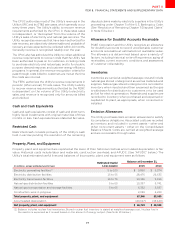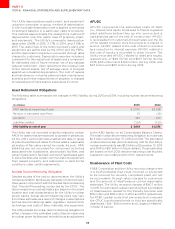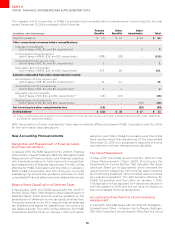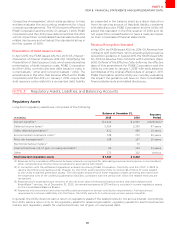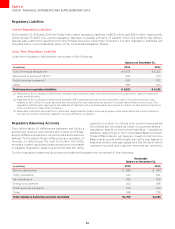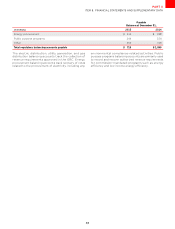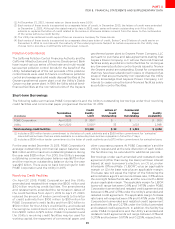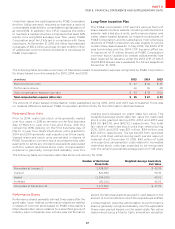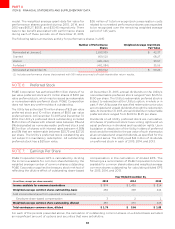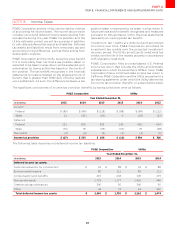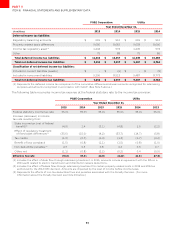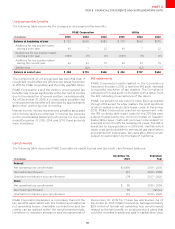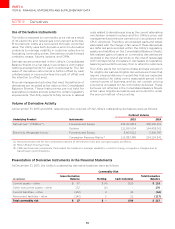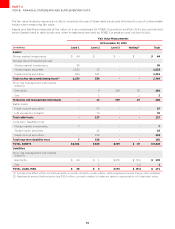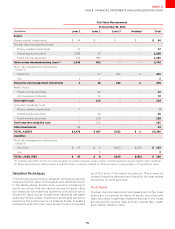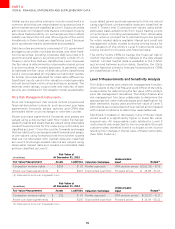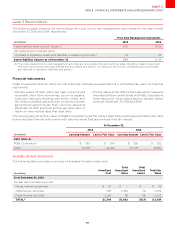PG&E 2015 Annual Report Download - page 95
Download and view the complete annual report
Please find page 95 of the 2015 PG&E annual report below. You can navigate through the pages in the report by either clicking on the pages listed below, or by using the keyword search tool below to find specific information within the annual report.
87
PART II
ITEM 8.FINANCIAL STATEMENTS AND SUPPLEMENTARY DATA
Under their respective credit agreements, PG&E Corporation
and the Utility are each required to maintain a ratio of
consolidated total debt to consolidated capitalization of
at most 65%. In addition, the CPUC requires the Utility
to maintain a capital structure composed of at least 52%
equity on a weighted average over four years. PG&E
Corporation and the Utility are in compliance with these
restrictions. At December 31, 2015, the Utility had restricted
net assets of $15.2 billion and was limited to $110 million
of additional common stock dividends it could pay to
PG&E Corporation.
Long-Term Incentive Plan
The PG&E Corporation LTIP permits various forms of
share-based incentive awards, including restricted stock
awards, restricted stock units, performance shares, and
other share-based awards, to eligible employees of
PG&E Corporation and its subsidiaries. Non-employee
directors of PG&E Corporation are also eligible to receive
certain share-based awards. In May 2014, the 2006 LTIP
was terminated and the 2014 LTIP became eective.
A maximum of 17 million shares of PG&E Corporation
common stock (subject to certain adjustments) has
been reserved for issuance under the 2014 LTIP, of which
15,674,803 shares were available for future awards at
December 31, 2015.
The following table provides a summary of total share-based compensation expense recognized by PG&E Corporation
for share-based incentive awards for 2015, 2014, and 2013:
(inmillions)
Restrictedstockunits
Performanceshares
Totalcompensationexpense(pre-tax)
Totalcompensationexpense(after-tax)
The amount of share-based compensation costs capitalized during 2015, 2014, and 2013 was immaterial. There was
no material dierence between PG&E Corporation and the Utility for the information disclosed above.
Restricted Stock Units
Prior to 2014, restricted stock units generally vested
over four years in 20% increments on the first business
day of March in year one, two, and three, with the
remaining 40% vesting on the first business day of
March in year four. Restricted stock units granted in
2014 and 2015 generally vest equally over three years.
Vested restricted stock units are settled in shares of
PG&E Corporation common stock accompanied by cash
payments to settle any dividend equivalents associated
with the vested restricted stock units. Compensation
expense is generally recognized rateably over the
vesting period based on grant-date fair value. The
weighted average grant-date fair value for restricted
stock units granted during 2015, 2014, and 2013 was
$53.30, $43.76, and $42.92, respectively. The total
fair value of restricted stock units that vested during
2015, 2014, and 2013 was $57 million, $34 million, and
$30 million, respectively. The tax benefit from restricted
stock units that vested during each period was not
material. As of December 31, 2015, $45 million of total
unrecognized compensation costs related to nonvested
restricted stock units was expected to be recognized
over the remaining weighted average period of 1.48 years.
The following table summarizes restricted stock unit activity for 2015:
NumberofRestricted
StockUnits
WeightedAverageGrant-Date
FairValue
NonvestedatJanuary
Granted
Vested ()
Forfeited ()
NonvestedatDecember
Performance Shares
Performance shares generally will vest three years after the
grant date. Upon vesting, performance shares are settled
in shares of common stock based on PG&E Corporation’s
total shareholder return relative to a specified group of
industry peer companies over a three-year performance
period. Dividend equivalents are paid in cash based on the
amount of common stock to which the recipients are entitled.
Compensation expense attributable to performance
share is generally recognized rateably over the applicable
three-year period based on the grant-date fair value
determined using a Monte Carlo simulation valuation


